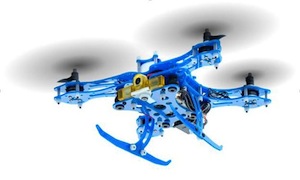 Ubuntu got a big boost as a competitive operating system for drones with an Unmanned Aerial Vehicle (UAV) reference platform announced by Qualcomm last week called Snapdragon Flight. The Snapdragon 801 based development platform supports Linaro’s version of Ubuntu, as well as OpenCV, according to an email to Linux.com from a Qualcomm representative. The rep went on the call it “an open platform for companies to port their own existing drone software.”
Ubuntu got a big boost as a competitive operating system for drones with an Unmanned Aerial Vehicle (UAV) reference platform announced by Qualcomm last week called Snapdragon Flight. The Snapdragon 801 based development platform supports Linaro’s version of Ubuntu, as well as OpenCV, according to an email to Linux.com from a Qualcomm representative. The rep went on the call it “an open platform for companies to port their own existing drone software.”
The 58x40mm SBC supports 4K stereo VGA video cameras and optic flow cameras, and it offers dual-band 802.11n WiFi, Bluetooth 4.0, and 5Hz GNSS (GPS). It provides a variety of sensors, including inertial measurement unit (IMU) and barometer sensors and offers ports for additional sensors. It will also support “advanced real-time flight control” with the help of the Snapdragon 801 system-on-chip’s Hexagon DSP.
“The Qualcomm Snapdragon Flight brings together the technologies that have defined the mobile industry onto a single board, enabling OEMs to build drones that are lighter, smaller, easy to use and affordable with long battery life and superior functionalities,” stated Raj Talluri, Qualcomm Technologies’ SVP of product management, in the Qualcomm announcement.
Snapdragon Flight targets a variety of robotics applications but is primarily focused on consumer drones that are cheaper than the prosumer DJI Phantom, 3DR Solo, or Yuneec Typhoon, which range from $1,000 to $1,450. These include high-end Phantom and Typhoon quadcopters that offer 4K cameras.
Qualcomm says that Yuneec will be one of the first companies to use Snapdragon Flight, which it will adopt for a drone due in 2016. Last week, Intel announced it was investing more than $60 million in the Hong Kong based company, which appears to follow only China’s DJI in market share in the prosumer drone space.

There were few details about the Intel partnership, but Intel CEO Brian Krzanich stated at the time that “We’ve got drones on our road map that are going to truly change the world and revolutionize the industry.” Yuneec’s choice of Snapdragon Flight suggests that Yuneec won’t be using Intel processors but rather its RealSense 3D cameras. It’s possible, however, that they may be testing a variety of models using different processor platforms.
Yuneec doesn’t say what OS runs on the current Typhoon models, although the drones’ touchscreen-enabled controllers run Android. Yuneec was a founding member of the Linux Foundation’s open source Dronecode platform. Another founding member was 3DR, which contributed its APM platform for UAV autopilots (formerly called “ArduPilot”) as the basis for Droneocde. Earlier this year, 3DR launched the Linux-based Solo quadcopter.
Qualcomm’s Snapdragon 801 has appeared in several high-end Android devices including the Samsung Galaxy S5. Like other high-end Snapdragon SoCs, however, it also supports Linaro’s version of Ubuntu, which will run on the Snapdragon Flight.
The Snapdragon 801 supplies four Krait cores that are roughly equivalent to Cortex-A15 cores clocked to 2.26GHz. Other features include an Adreno 330 GPU, the Hexagon DSP, a dedicated video encode engine, and dual image signal processors (ISPs). These features will combine on drones running Snapdragon Flight to provide “advanced drone features such as obstacle avoidance and video stabilization,” says the chipmaker.
The consolidation of features in the Snapdragon 801 and Snapdragon Flight board will enable cheaper, lighter 4K ready consumer drones, says Qualcomm. A Wired report suggests Snapdragon Flight-based UAVs will aim for a mid-range consumer price similar to Parrot’s $300, Linux-based AR.Drone. France-based Parrot also sells a more advanced, Linux-based Bebop quadcopter, which sells for $500 to $800.
The only other drones we know that have publicly acknowledged running Ubuntu are the Erle-Robotics Erle-Copter and similar models, which run both standard Ubuntu as well as the new, lightweight Snappy Ubuntu. Both also depend on Robot Operating System (ROS) and APM autopilot firmware. The first Linux reference platform for the open source ROS was a Snapdragon 600.
Earlier this week, Erle Robotics launched an Indiegogo campaign for a six-legged Erle-Spider robot running Snappy Ubuntu Core on a Raspberry Pi 2 Model B board. Packages start at $400. The embedded-oriented Snappy provides features like secure, transactional updates, as well as an open source app development platform and an app store.
Snapdragon Flight will instead run the more robust standard Linaro version of Ubuntu, according to the Qualcomm rep. This should still enable app downloads, although without the secure, transactional updates.
If the claims of much longer battery life are true, this would be a major selling point, considering that most drones last only about 20 minutes before they need to return to home base. Because recharges tend to take about an hour, many drone owners buy at least one more battery, adding to the overall cost. The announcement mentions a Qualcomm Quick Charge technology, which should address that limitation, as well.
Snapdragon Flight is available today for select OEMs and is expected to be available in commercially available drones by the first half of 2016, says Qualcomm.


